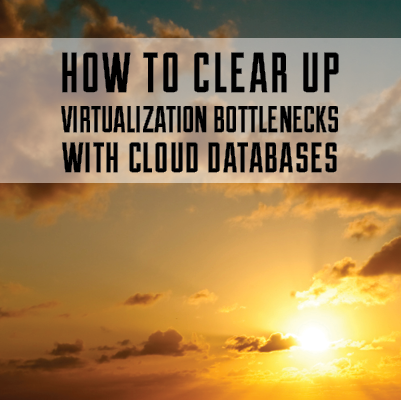Clear Up Virtualization Bottlenecks With Cloud Databases

 Just as data has become exponentially larger and more complex than it was a few short years ago, database technology has definitely followed suit. A huge part of the evolution of database technology is that it has migrated to the cloud.
Just as data has become exponentially larger and more complex than it was a few short years ago, database technology has definitely followed suit. A huge part of the evolution of database technology is that it has migrated to the cloud.
Plenty of reasons exist for this, but the most pressing have to do with the complexity of data. Relational databases are losing ground as efficient resources for managing databases, which is largely due to the fact that user data from massive social networking and cloud computing organizations has made the situation more complicated.
In an effort to completely circumvent bottlenecks and performance blockages posed by virtualization hardware, IT pros are turning to nonrelational databases such as NoSQL to ensure this flexible data can be managed seamlessly across multiple platforms.
What is a Cloud Database?
This is an important question to answer, especially if you’re making a decision to choose a cloud database resource over traditional virtualization. At its core, a cloud database isn’t any different from any other cloud-based service. In a nutshell, a cloud database service—also known as Database-as-a-Service (DBaaS)—is a database delivered to users via a web-based portal from a cloud service provider’s servers.
Examples of Cloud-compatible Databases
Two common database modes can deployed in the cloud:
- SQL: Structured Query Language (SQL) is widely known as the de facto language for managing structured databases. Many of these types of databases have migrated to the cloud in recent years, and SQL services are all cloud-based solutions for SQL-based databases. Although these cloud databases don’t necessarily solve the virtualization bottleneck problem, they make relational or structured databases easier to manage for database architects and administrators.
- NoSQL: NoSQL has caught on in a big way as the best way to manage and deploy nonrelational databases. In fact, as the DBaaS market has grown, NoSQL cloud providers are getting the most notice as more large-scale organizations switch from traditional structured database management to non-structured database management. NoSQL DBaaS providers, such as MongoDB, have dominated the cloud database industry in recent months. Each provider has its own benefits and disadvantages. For instance, MongoDB is easily the most powerful open-source NoSQL database on the market, but it’s incredibly complex to manage in the cloud. In any case, NoSQL providers are still giving database administrators a way around the bottlenecks wrapped up in virtualization hardware technology.
Why Cloud Database Management?
The answer is fairly simple, but the implementation is incredibly complex. Cloud databases—especially those of the non-structured variety—offer advantages that previously weren’t accessible through virtualization. This includes everything from automatic failover to automated scaling for complex data to minimal-to-zero investment of in-house database management hardware. Although potential drawbacks exist, such as security, privacy and potential data loss, cloud-based database management offers an unprecedented level of support for all the complex tasks that have been plaguing database architects, administrators and engineers for years.





